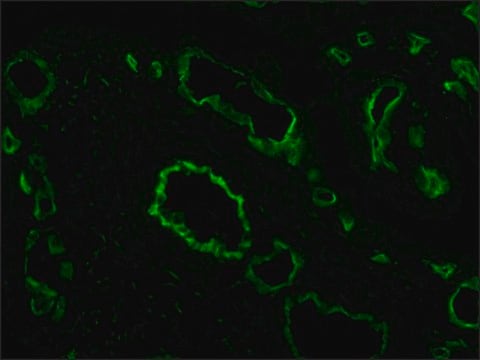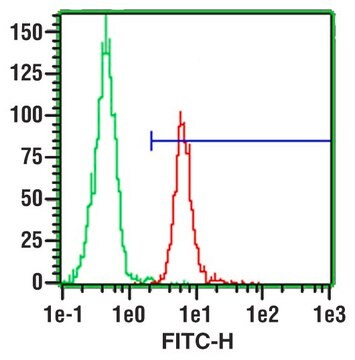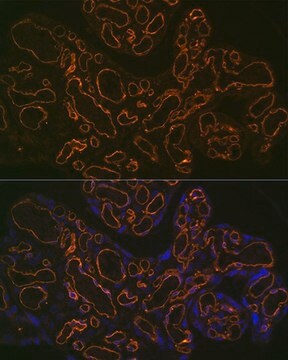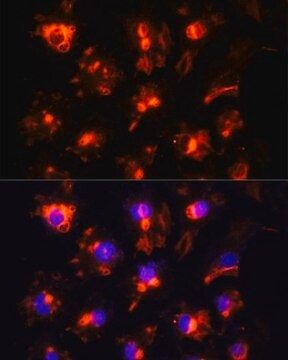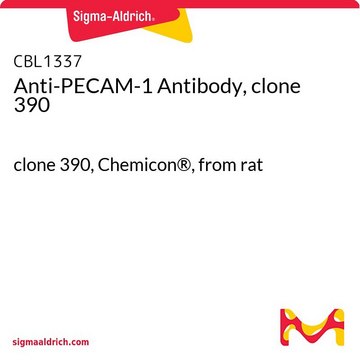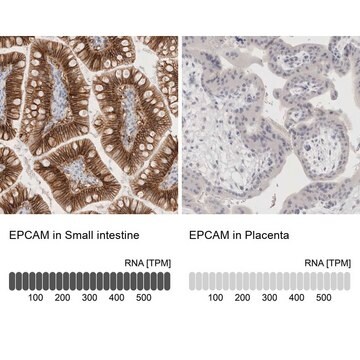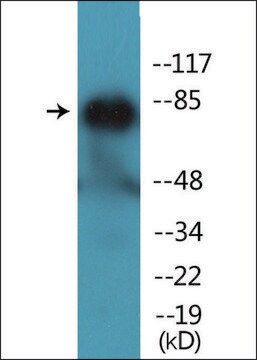MAB1398Z
Anti-PECAM-1 Antibody, clone 2H8, Azide Free
clone 2H8, Chemicon®, from hamster(Armenian)
Synonim(y):
CD31, PECAM-1, Platelet endothelial cell adhesion molecule
About This Item
Polecane produkty
pochodzenie biologiczne
hamster (Armenian)
Poziom jakości
forma przeciwciała
purified immunoglobulin
rodzaj przeciwciała
primary antibodies
klon
2H8, monoclonal
reaktywność gatunkowa
mouse, canine
producent / nazwa handlowa
Chemicon®
metody
electron microscopy: suitable
flow cytometry: suitable
immunocytochemistry: suitable
immunofluorescence: suitable
immunohistochemistry: suitable
immunoprecipitation (IP): suitable
neutralization: suitable
izotyp
IgG
numer dostępu NCBI
numer dostępu UniProt
Warunki transportu
dry ice
docelowa modyfikacja potranslacyjna
unmodified
informacje o genach
dog ... Pecam1(610775)
mouse ... Pecam1(18613)
Powiązane kategorie
Opis ogólny
CD31 has been used to measure angiogenesis in association with tumor recurrence. Other studies have also indicated that CD31 and CD34 can be used as markers for myeloid progenitor cells and recognize different subsets of myeloid leukemia infiltrates (granular sarcomas).
Specyficzność
Immunogen
Zastosowanie
Immunofluorescence Analysis: A representative lot immunostained endothelial cells in formalin-fixed, paraffin-embedded murine peritoneum sections by fluorescent immunohistochemistry (Tanabe, K., et al. (2007). Kidney Int. 71(3):227-238).
Immunocytochemistry Analysis: A representative lot immunostained 4% paraformaldehyde-fixed endothelial cells differentiated from murine ESCs in cultures (Purpura, K.A., et al. (2008). Stem Cells. 26(11):2832-2842).
Immunocytochemistry Analysis: Clone 2H8 immunostained 3% paraformaldehyde-fixed, 0.5% NP-40-permeabilized COS-7 transfectants expressing murine, but not human, CD31 by fluorescent immunocytochemistry (Bogen, S.A., et al. (1992). Am. J. Pathol. 141(4):843-854).
Neutralization Analysis: A representative lot, when injected intravenously in mice, blocked leukocyte emigration in response to thioglycollate injection (Bogen, S., et al. (1994). J. Exp. Med. 179(3):1059-1064).
Neutralization Analysis: A representative lot blocked murine PECAM-mediated aggregation of mouse L cells (Xie, Y., and Muller, W.A. (1993). Proc. Natl. Acad. Sci. U. S. A. 190(12):5569-5573).
Flow Cytometry Analysis: A representative lot detected the expression of exogenously transfected murine CD31 on the surface of mouse L cells (Xie, Y., and Muller, W.A. (1993). Proc. Natl. Acad. Sci. U. S. A. 190(12):5569-5573).
Flow Cytometry Analysis: Clone 2H8 detected CD31 immunoreactivity on the surface of various murine B- and T-cell lines (Bogen, S.A., et al. (1992). Am. J. Pathol. 141(4):843-854).
Immunoprecipitation Analysis: A representative lot immunoprecipitated exogenously expressed murine, but not human, CD31 from COS-7 transfectants (Xie, Y., and Muller, W.A. (1993). Proc. Natl. Acad. Sci. U. S. A. 190(12):5569-5573).
Immunoprecipitation Analysis: Clone 2H8 immunoprecipitated CD31 from murine CTLL T lymphocytes and Sp2/0 B lymphocytes (Bogen, S.A., et al. (1992). Am. J. Pathol. 141(4):843-854).
Electron Microscopy Analysis: Clone 2H8 was biotinylated and immunostained lymphocytes in 0.01% glutaraldehyde-/2% formaldehyde-fxed frozen reactive lymph node tissues from KLH-immunized mice (Bogen, S.A., et al. (1992). Am. J. Pathol. 141(4):843-854).
Immunohistochemistry Analysis: Clone 2H8 immunostained lymphocytes adherent to the sinusoidal and postcapillary venular endothelium of frozen reactive lymph node tissues from KLH-immunized mice (Bogen, S.A., et al. (1992). Am. J. Pathol. 141(4):843-854).
Cell Structure
Adhesion (CAMs)
Powiązanie
Postać fizyczna
Przechowywanie i stabilność
Komentarz do analizy
Mouse cell lung tissue
Inne uwagi
Informacje prawne
Oświadczenie o zrzeczeniu się odpowiedzialności
Nie możesz znaleźć właściwego produktu?
Wypróbuj nasz Narzędzie selektora produktów.
Kod klasy składowania
12 - Non Combustible Liquids
Klasa zagrożenia wodnego (WGK)
WGK 2
Temperatura zapłonu (°F)
Not applicable
Temperatura zapłonu (°C)
Not applicable
Certyfikaty analizy (CoA)
Poszukaj Certyfikaty analizy (CoA), wpisując numer partii/serii produktów. Numery serii i partii można znaleźć na etykiecie produktu po słowach „seria” lub „partia”.
Masz już ten produkt?
Dokumenty związane z niedawno zakupionymi produktami zostały zamieszczone w Bibliotece dokumentów.
Produkty
Końcówki do wyboru barwników do cytometrii przepływowej dopasowują fluorofory do konfiguracji cytometru przepływowego, zwiększając wydajność panelu.
Protokoły
Zapoznaj się z naszym przewodnikiem po cytometrii przepływowej, aby odkryć podstawy cytometrii przepływowej, tradycyjne komponenty cytometru przepływowego, kluczowe etapy protokołu cytometrii przepływowej i odpowiednie kontrole.
Nasz zespół naukowców ma doświadczenie we wszystkich obszarach badań, w tym w naukach przyrodniczych, materiałoznawstwie, syntezie chemicznej, chromatografii, analityce i wielu innych dziedzinach.
Skontaktuj się z zespołem ds. pomocy technicznej